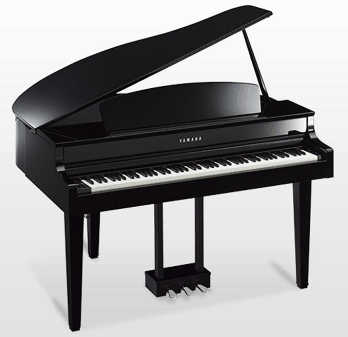A piano is a sound investment in more ways than one! How will you decide what kind of piano is the best for you? A quality piano will be part of your family for decades, even generations. A good rule of thumb is to buy the best piano you can afford. Making music on a quality instrument is one the best ways to keep young students motivated, and enjoy playing the piano yourself.
Vertical Pianos
The spinet piano was first produced in 1935. Its low cost and reduced height, between 35 and 39 inches, made it a popular choice after World War II. Console pianos are 40″ to 43″ tall. Longer strings and a larger soundboard generally improve the tone of a piano.
Studio pianos from 45 to 48 inches tall are often found in schools, studios and more and more frequently, in living rooms. String length and soundboard size are comparable to those of smaller grands. Professional upright pianos are those ranging in height from 49 to 52 inches and offer the most power in a vertical piano.
Grand Pianos
Grand pianos designed for the home have become very popular in recent years. If space is a consideration, use a paper pattern, available from most piano dealers, on the floor to measure. You may be surprised to find you have room for a larger piano! Grand piano models start at under five feet in length. Six foot grands are a popular choice for piano teachers and serious amateurs. The largest grands are seven to nine feet and are used primarily for public performance in concert halls, churches and auditoriums.
The Piano Inside and Out
Today’s modern piano is a marvel of engineering that depends on impeccable craftsmanship and unflagging care to produce good music. As a result of technological improvements, the piano has profited greatly in tone and performance and is superior to its early predecessors. Let’s take a look at the different parts of the piano.
Piano strings are made of high grade steel drawn to exact sizes. Bass strings are wound with copper wire to add mass to the sound. The plate is made of cast iron and is bolted to the frame. It anchors most of the 20 tons of pull exerted by the strings. At the top of the plate, the strings are wound through and around tuning pins that are set in a pin block. The pin block is constructed of layers of hard wood to grip the pins in place for better tuning stability.
The soundboard, which is made from fine grain spruce, amplifies the vibrations of the strings. The hard maple bridges across the treble and bass transfer the vibrations of the strings to the soundboard.
Components called the “action” are made up of as many as 9,000 parts. Each part plays a role in making the hammers strike the strings when keys are played. Grand pianos have horizontal actions and upright pianos have vertical actions.
Piano hammers are made from sheets of felt molded around a wooden hammer under tremendous pressure. A 12-pound hammer refers to the weight of the felt used to make the hammer and not its actual weight.
Today’s piano keys are almost never made from ivory. Instead, piano manufactures use a fine molded resin that doesn’t crack or yellow. The black keys are made of a similar material. Piano keys are balanced by a center pin and bushed with a fine wood for proper clearance and quiet operation.
Pianos may have two or three pedals. The sustaining, or damper pedal, is on the right and lifts the dampers away from the strings so that the notes will continue to sound after the keys are released. The pedal on the left, the “una corda” or “soft” pedal, reduces the tone by shortening the distance the hammers travel. In grands, the action shifts slightly so fewer strings are struck. Some pianos have a third pedal for sustaining bass notes only. On most grands and on some verticals, the third pedal is called a “sostenuto”. Some pianos use the third pedal for activating a practice mute.
Finally, there is the cabinet. Modern cabinets are made of core stock overlaid with veneers of fine furniture wood. Many grains and finished are available and modern finishing techniques assure excellent appearance and easy care for years.
